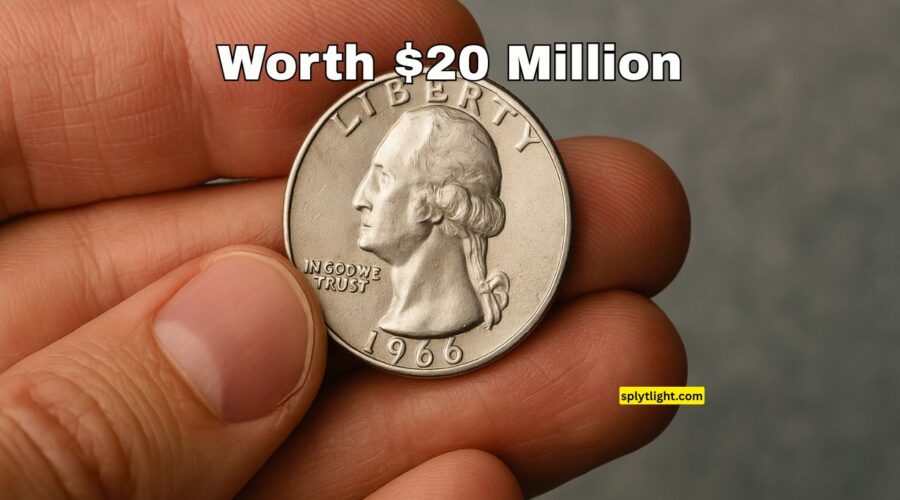Rare 1966 Washington Quarter Error Coin- Could It Be Worth $20 Million?
The 1966 Washington Quarter has garnered attention in numismatic circles, with rumors suggesting that certain error coins from this year could be worth up to $20 million.
While such claims are largely unverified, the 1966 quarter does hold significant value for collectors, especially those with rare errors or in exceptional condition.
Historical Context: The 1966 Quarter
In 1966, the U.S. Mint was transitioning from silver to a copper-nickel clad composition for quarters. This change aimed to address coin shortages and reduce production costs.
Notably, from 1965 to 1967, the Mint removed all mint marks to discourage hoarding by collectors. As a result, all 1966 quarters lack a mint mark, regardless of their mint of origin.
Notable Error Types in 1966 Quarters
Error coins are highly sought after due to their rarity and uniqueness. Some of the notable error types found in 1966 Washington Quarters include:
- Doubled Die Reverse (DDR): This error occurs when the coin’s reverse design is struck twice, slightly offset, leading to a noticeable doubling effect.
- Off-Center Strikes: These coins are misaligned during striking, resulting in a portion of the design missing.
- Clipped Planchets: A portion of the coin’s edge is missing due to a mishap during the blanking process.
- Struck on Wrong Planchet: Occasionally, a quarter design is struck on a planchet intended for another denomination, leading to size and weight anomalies.
- Missing Clad Layer: These coins are missing the outer nickel layer, exposing the copper core and giving the coin a distinct appearance.
Valuation of 1966 Washington Quarters
The value of a 1966 Washington Quarter varies based on its condition, rarity, and presence of errors. Below is a table summarizing the estimated values:
| Coin Type | Grade | Estimated Value (USD) | Notes |
|---|---|---|---|
| Regular Strike (No Mint Mark) | MS60 | $0.25 | Face value |
| Regular Strike (No Mint Mark) | MS67 | $275 | High-grade specimens are rare |
| Regular Strike (No Mint Mark) | MS68+ | $21,000 | Record auction sale in May 2023 |
| Special Mint Set (SMS) | SP64 | $7.50 | Slightly better than circulation coins |
| Special Mint Set (SMS) | SP67 | $1,380 | High-grade SMS coins are valuable |
| Special Mint Set (SMS) – Cameo (CAM) | SP65 | $32 | Features frosted design elements |
| Special Mint Set (SMS) – Deep Cameo (DCAM) | SP67 | $2,650 | Strong contrast between frosted and mirrored areas |
| Doubled Die Reverse (DDR) | XF45 | $920 | Error coin with noticeable doubling |
| Off-Center Strike | AU | $70 | Misaligned strike leading to partial design |
| Missing Clad Layer | – | $75 | Exposes the copper core |
| Struck on Wrong Planchet | – | $200 | Quarter design on incorrect planchet |
Note: Values are approximate and can vary based on market demand and coin condition.
Understanding the $20 Million Claim
The assertion that a 1966 Washington Quarter could be worth $20 million is largely speculative and lacks concrete evidence.
While rare error coins can fetch high prices, no 1966 quarter has been documented to sell for such an amount.
The highest recorded sale for a 1966 quarter is $21,000 for a coin graded MS68+ by PCGS in May 2023.
Tips for Collectors
- Examine Your Coins: Use a magnifying glass to look for errors such as doubling, off-center strikes, or missing layers.
- Weigh Your Coins: A standard 1966 quarter should weigh approximately 5.67 grams. Significant deviations might indicate a wrong planchet error.
- Seek Professional Grading: If you believe you have a valuable coin, consider having it graded by reputable services like PCGS or NGC.
- Stay Informed: Join numismatic forums and communities to stay updated on coin values and market trends.
While the idea of a 1966 Washington Quarter being worth $20 million is enticing, it’s essential to approach such claims with skepticism.
Nonetheless, certain 1966 quarters, especially those with rare errors or in exceptional condition, can be quite valuable.
Collectors should remain vigilant, educate themselves on identifying errors, and consult with professionals to ascertain the true value of their coins.
FAQs
Why do 1966 quarters lack a mint mark?
From 1965 to 1967, the U.S. Mint removed mint marks from coins to discourage hoarding during a coin shortage.
How can I identify a Doubled Die Reverse error?
Look for noticeable doubling in the lettering or design elements on the coin’s reverse side.
Are all error coins valuable?
Not necessarily. The value depends on the type of error, its visibility, and the coin’s overall condition.


Leave a Reply